Business Law: Negligence and Liability in Donoghue v Stevenson Case
VerifiedAdded on 2023/06/05
|7
|2250
|389
Homework Assignment
AI Summary
This assignment analyzes a business law case involving negligence, specifically addressing the issue of whether Susan is liable for the financial and personal injuries suffered by Cliff and Mary. The analysis begins by defining negligence and its key elements, including duty of care, breach of duty, causation, and remoteness of damages, referencing landmark cases such as Donoghue v Stevenson and Home Office v Dorset Yacht Co Ltd. The assignment applies these principles to the scenario where Susan keeps a Bengal tiger, Benji, and evaluates whether Susan owed a duty of care to her neighbors, Cliff and Mary, and whether she breached that duty, leading to their injuries when Benji escaped. The analysis concludes that Susan is not liable because she maintained a reasonable standard of care, and the damages were too remote, emphasizing the absence of a breach of duty and the unforeseeability of the incident. The assignment also briefly touches on potential defenses such as contributory negligence and voluntary assumption of risk, though they are not applicable in this specific case. The conclusion supports that Cliff and Mary cannot sue Susan for negligence.

BUSINESS LAW
Paraphrase This Document
Need a fresh take? Get an instant paraphrase of this document with our AI Paraphraser
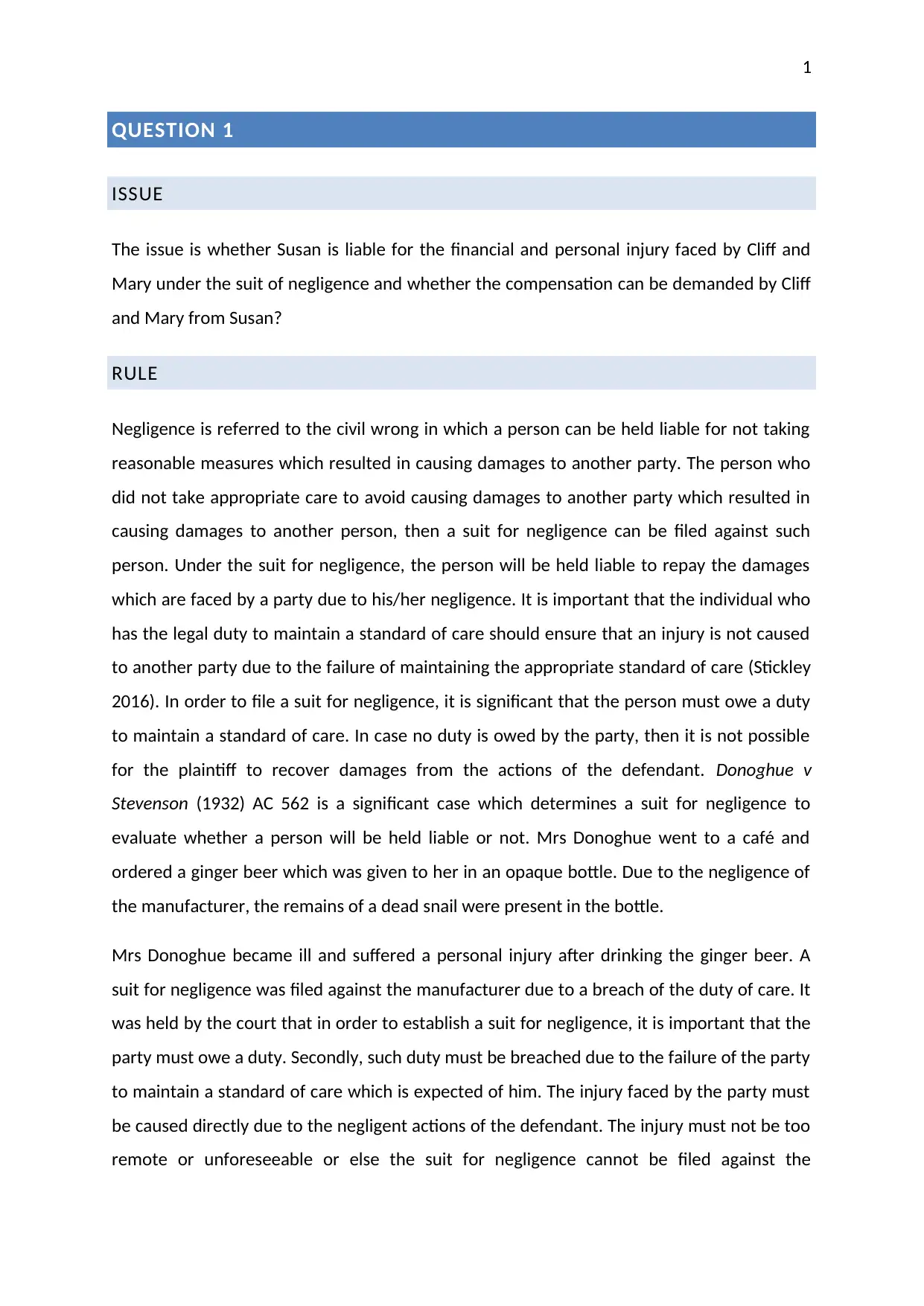
1
QUESTION 1
ISSUE
The issue is whether Susan is liable for the financial and personal injury faced by Cliff and
Mary under the suit of negligence and whether the compensation can be demanded by Cliff
and Mary from Susan?
RULE
Negligence is referred to the civil wrong in which a person can be held liable for not taking
reasonable measures which resulted in causing damages to another party. The person who
did not take appropriate care to avoid causing damages to another party which resulted in
causing damages to another person, then a suit for negligence can be filed against such
person. Under the suit for negligence, the person will be held liable to repay the damages
which are faced by a party due to his/her negligence. It is important that the individual who
has the legal duty to maintain a standard of care should ensure that an injury is not caused
to another party due to the failure of maintaining the appropriate standard of care (Stickley
2016). In order to file a suit for negligence, it is significant that the person must owe a duty
to maintain a standard of care. In case no duty is owed by the party, then it is not possible
for the plaintiff to recover damages from the actions of the defendant. Donoghue v
Stevenson (1932) AC 562 is a significant case which determines a suit for negligence to
evaluate whether a person will be held liable or not. Mrs Donoghue went to a café and
ordered a ginger beer which was given to her in an opaque bottle. Due to the negligence of
the manufacturer, the remains of a dead snail were present in the bottle.
Mrs Donoghue became ill and suffered a personal injury after drinking the ginger beer. A
suit for negligence was filed against the manufacturer due to a breach of the duty of care. It
was held by the court that in order to establish a suit for negligence, it is important that the
party must owe a duty. Secondly, such duty must be breached due to the failure of the party
to maintain a standard of care which is expected of him. The injury faced by the party must
be caused directly due to the negligent actions of the defendant. The injury must not be too
remote or unforeseeable or else the suit for negligence cannot be filed against the
QUESTION 1
ISSUE
The issue is whether Susan is liable for the financial and personal injury faced by Cliff and
Mary under the suit of negligence and whether the compensation can be demanded by Cliff
and Mary from Susan?
RULE
Negligence is referred to the civil wrong in which a person can be held liable for not taking
reasonable measures which resulted in causing damages to another party. The person who
did not take appropriate care to avoid causing damages to another party which resulted in
causing damages to another person, then a suit for negligence can be filed against such
person. Under the suit for negligence, the person will be held liable to repay the damages
which are faced by a party due to his/her negligence. It is important that the individual who
has the legal duty to maintain a standard of care should ensure that an injury is not caused
to another party due to the failure of maintaining the appropriate standard of care (Stickley
2016). In order to file a suit for negligence, it is significant that the person must owe a duty
to maintain a standard of care. In case no duty is owed by the party, then it is not possible
for the plaintiff to recover damages from the actions of the defendant. Donoghue v
Stevenson (1932) AC 562 is a significant case which determines a suit for negligence to
evaluate whether a person will be held liable or not. Mrs Donoghue went to a café and
ordered a ginger beer which was given to her in an opaque bottle. Due to the negligence of
the manufacturer, the remains of a dead snail were present in the bottle.
Mrs Donoghue became ill and suffered a personal injury after drinking the ginger beer. A
suit for negligence was filed against the manufacturer due to a breach of the duty of care. It
was held by the court that in order to establish a suit for negligence, it is important that the
party must owe a duty. Secondly, such duty must be breached due to the failure of the party
to maintain a standard of care which is expected of him. The injury faced by the party must
be caused directly due to the negligent actions of the defendant. The injury must not be too
remote or unforeseeable or else the suit for negligence cannot be filed against the
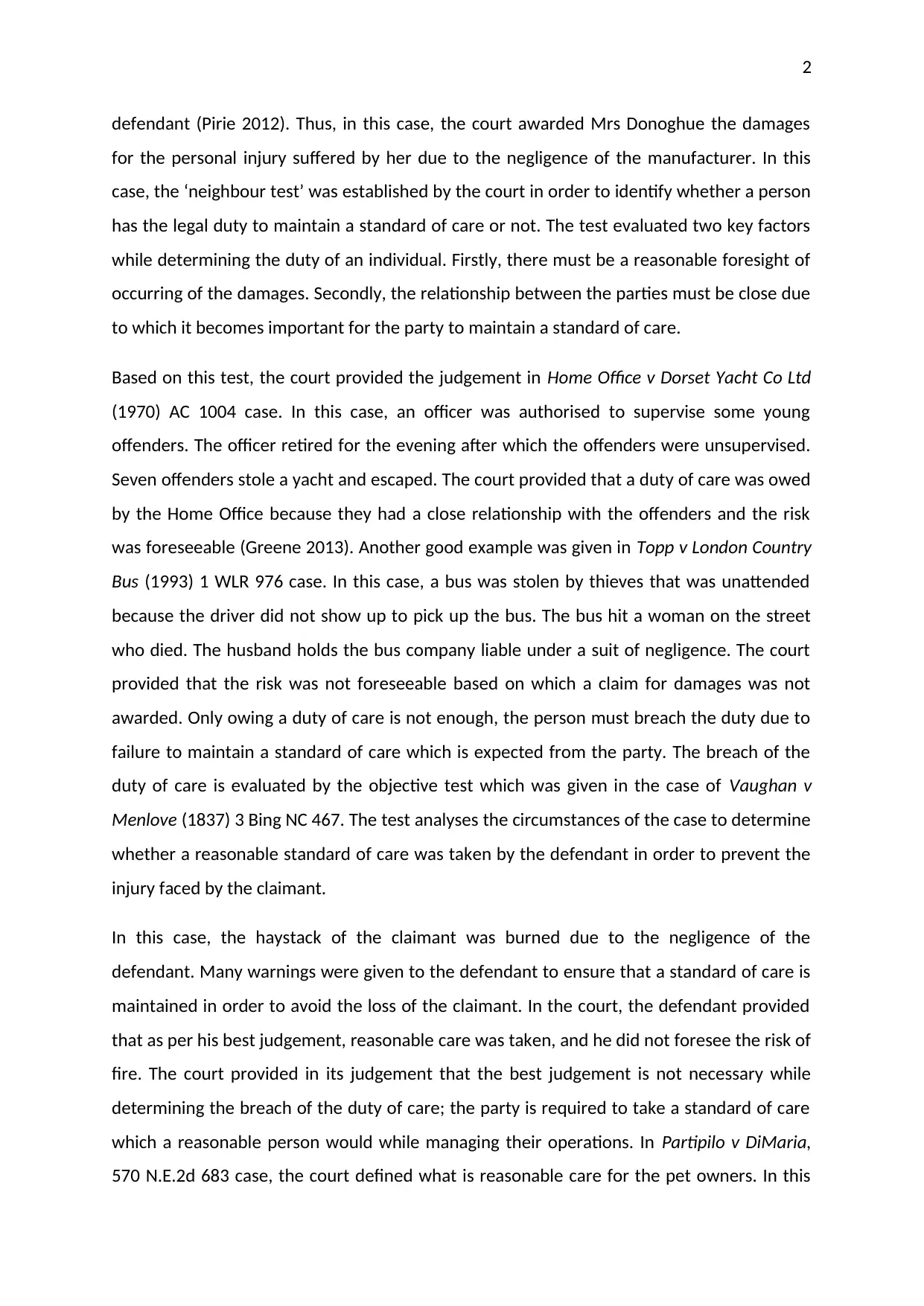
2
defendant (Pirie 2012). Thus, in this case, the court awarded Mrs Donoghue the damages
for the personal injury suffered by her due to the negligence of the manufacturer. In this
case, the ‘neighbour test’ was established by the court in order to identify whether a person
has the legal duty to maintain a standard of care or not. The test evaluated two key factors
while determining the duty of an individual. Firstly, there must be a reasonable foresight of
occurring of the damages. Secondly, the relationship between the parties must be close due
to which it becomes important for the party to maintain a standard of care.
Based on this test, the court provided the judgement in Home Office v Dorset Yacht Co Ltd
(1970) AC 1004 case. In this case, an officer was authorised to supervise some young
offenders. The officer retired for the evening after which the offenders were unsupervised.
Seven offenders stole a yacht and escaped. The court provided that a duty of care was owed
by the Home Office because they had a close relationship with the offenders and the risk
was foreseeable (Greene 2013). Another good example was given in Topp v London Country
Bus (1993) 1 WLR 976 case. In this case, a bus was stolen by thieves that was unattended
because the driver did not show up to pick up the bus. The bus hit a woman on the street
who died. The husband holds the bus company liable under a suit of negligence. The court
provided that the risk was not foreseeable based on which a claim for damages was not
awarded. Only owing a duty of care is not enough, the person must breach the duty due to
failure to maintain a standard of care which is expected from the party. The breach of the
duty of care is evaluated by the objective test which was given in the case of Vaughan v
Menlove (1837) 3 Bing NC 467. The test analyses the circumstances of the case to determine
whether a reasonable standard of care was taken by the defendant in order to prevent the
injury faced by the claimant.
In this case, the haystack of the claimant was burned due to the negligence of the
defendant. Many warnings were given to the defendant to ensure that a standard of care is
maintained in order to avoid the loss of the claimant. In the court, the defendant provided
that as per his best judgement, reasonable care was taken, and he did not foresee the risk of
fire. The court provided in its judgement that the best judgement is not necessary while
determining the breach of the duty of care; the party is required to take a standard of care
which a reasonable person would while managing their operations. In Partipilo v DiMaria,
570 N.E.2d 683 case, the court defined what is reasonable care for the pet owners. In this
defendant (Pirie 2012). Thus, in this case, the court awarded Mrs Donoghue the damages
for the personal injury suffered by her due to the negligence of the manufacturer. In this
case, the ‘neighbour test’ was established by the court in order to identify whether a person
has the legal duty to maintain a standard of care or not. The test evaluated two key factors
while determining the duty of an individual. Firstly, there must be a reasonable foresight of
occurring of the damages. Secondly, the relationship between the parties must be close due
to which it becomes important for the party to maintain a standard of care.
Based on this test, the court provided the judgement in Home Office v Dorset Yacht Co Ltd
(1970) AC 1004 case. In this case, an officer was authorised to supervise some young
offenders. The officer retired for the evening after which the offenders were unsupervised.
Seven offenders stole a yacht and escaped. The court provided that a duty of care was owed
by the Home Office because they had a close relationship with the offenders and the risk
was foreseeable (Greene 2013). Another good example was given in Topp v London Country
Bus (1993) 1 WLR 976 case. In this case, a bus was stolen by thieves that was unattended
because the driver did not show up to pick up the bus. The bus hit a woman on the street
who died. The husband holds the bus company liable under a suit of negligence. The court
provided that the risk was not foreseeable based on which a claim for damages was not
awarded. Only owing a duty of care is not enough, the person must breach the duty due to
failure to maintain a standard of care which is expected from the party. The breach of the
duty of care is evaluated by the objective test which was given in the case of Vaughan v
Menlove (1837) 3 Bing NC 467. The test analyses the circumstances of the case to determine
whether a reasonable standard of care was taken by the defendant in order to prevent the
injury faced by the claimant.
In this case, the haystack of the claimant was burned due to the negligence of the
defendant. Many warnings were given to the defendant to ensure that a standard of care is
maintained in order to avoid the loss of the claimant. In the court, the defendant provided
that as per his best judgement, reasonable care was taken, and he did not foresee the risk of
fire. The court provided in its judgement that the best judgement is not necessary while
determining the breach of the duty of care; the party is required to take a standard of care
which a reasonable person would while managing their operations. In Partipilo v DiMaria,
570 N.E.2d 683 case, the court defined what is reasonable care for the pet owners. In this
⊘ This is a preview!⊘
Do you want full access?
Subscribe today to unlock all pages.

Trusted by 1+ million students worldwide
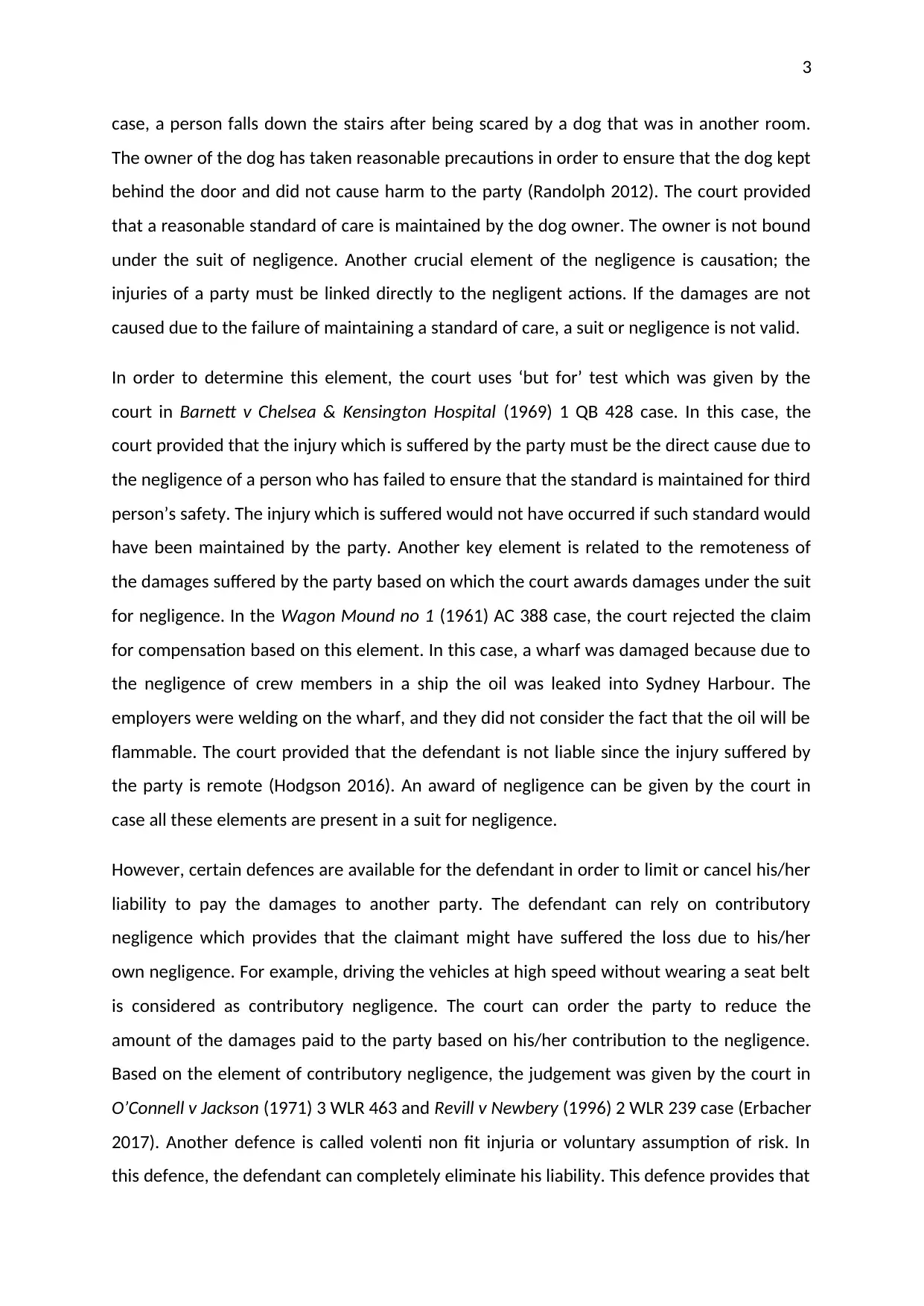
3
case, a person falls down the stairs after being scared by a dog that was in another room.
The owner of the dog has taken reasonable precautions in order to ensure that the dog kept
behind the door and did not cause harm to the party (Randolph 2012). The court provided
that a reasonable standard of care is maintained by the dog owner. The owner is not bound
under the suit of negligence. Another crucial element of the negligence is causation; the
injuries of a party must be linked directly to the negligent actions. If the damages are not
caused due to the failure of maintaining a standard of care, a suit or negligence is not valid.
In order to determine this element, the court uses ‘but for’ test which was given by the
court in Barnett v Chelsea & Kensington Hospital (1969) 1 QB 428 case. In this case, the
court provided that the injury which is suffered by the party must be the direct cause due to
the negligence of a person who has failed to ensure that the standard is maintained for third
person’s safety. The injury which is suffered would not have occurred if such standard would
have been maintained by the party. Another key element is related to the remoteness of
the damages suffered by the party based on which the court awards damages under the suit
for negligence. In the Wagon Mound no 1 (1961) AC 388 case, the court rejected the claim
for compensation based on this element. In this case, a wharf was damaged because due to
the negligence of crew members in a ship the oil was leaked into Sydney Harbour. The
employers were welding on the wharf, and they did not consider the fact that the oil will be
flammable. The court provided that the defendant is not liable since the injury suffered by
the party is remote (Hodgson 2016). An award of negligence can be given by the court in
case all these elements are present in a suit for negligence.
However, certain defences are available for the defendant in order to limit or cancel his/her
liability to pay the damages to another party. The defendant can rely on contributory
negligence which provides that the claimant might have suffered the loss due to his/her
own negligence. For example, driving the vehicles at high speed without wearing a seat belt
is considered as contributory negligence. The court can order the party to reduce the
amount of the damages paid to the party based on his/her contribution to the negligence.
Based on the element of contributory negligence, the judgement was given by the court in
O’Connell v Jackson (1971) 3 WLR 463 and Revill v Newbery (1996) 2 WLR 239 case (Erbacher
2017). Another defence is called volenti non fit injuria or voluntary assumption of risk. In
this defence, the defendant can completely eliminate his liability. This defence provides that
case, a person falls down the stairs after being scared by a dog that was in another room.
The owner of the dog has taken reasonable precautions in order to ensure that the dog kept
behind the door and did not cause harm to the party (Randolph 2012). The court provided
that a reasonable standard of care is maintained by the dog owner. The owner is not bound
under the suit of negligence. Another crucial element of the negligence is causation; the
injuries of a party must be linked directly to the negligent actions. If the damages are not
caused due to the failure of maintaining a standard of care, a suit or negligence is not valid.
In order to determine this element, the court uses ‘but for’ test which was given by the
court in Barnett v Chelsea & Kensington Hospital (1969) 1 QB 428 case. In this case, the
court provided that the injury which is suffered by the party must be the direct cause due to
the negligence of a person who has failed to ensure that the standard is maintained for third
person’s safety. The injury which is suffered would not have occurred if such standard would
have been maintained by the party. Another key element is related to the remoteness of
the damages suffered by the party based on which the court awards damages under the suit
for negligence. In the Wagon Mound no 1 (1961) AC 388 case, the court rejected the claim
for compensation based on this element. In this case, a wharf was damaged because due to
the negligence of crew members in a ship the oil was leaked into Sydney Harbour. The
employers were welding on the wharf, and they did not consider the fact that the oil will be
flammable. The court provided that the defendant is not liable since the injury suffered by
the party is remote (Hodgson 2016). An award of negligence can be given by the court in
case all these elements are present in a suit for negligence.
However, certain defences are available for the defendant in order to limit or cancel his/her
liability to pay the damages to another party. The defendant can rely on contributory
negligence which provides that the claimant might have suffered the loss due to his/her
own negligence. For example, driving the vehicles at high speed without wearing a seat belt
is considered as contributory negligence. The court can order the party to reduce the
amount of the damages paid to the party based on his/her contribution to the negligence.
Based on the element of contributory negligence, the judgement was given by the court in
O’Connell v Jackson (1971) 3 WLR 463 and Revill v Newbery (1996) 2 WLR 239 case (Erbacher
2017). Another defence is called volenti non fit injuria or voluntary assumption of risk. In
this defence, the defendant can completely eliminate his liability. This defence provides that
Paraphrase This Document
Need a fresh take? Get an instant paraphrase of this document with our AI Paraphraser
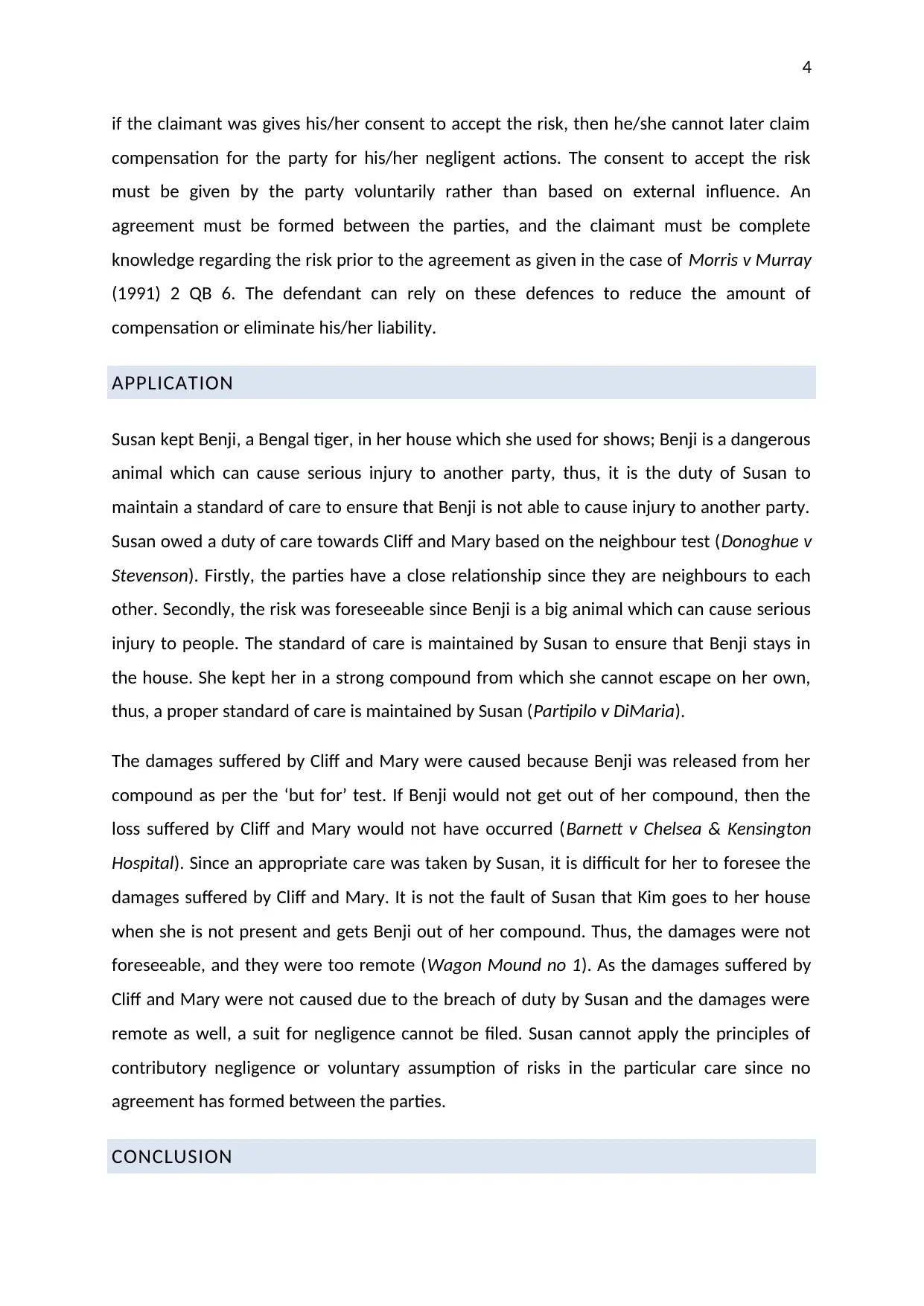
4
if the claimant was gives his/her consent to accept the risk, then he/she cannot later claim
compensation for the party for his/her negligent actions. The consent to accept the risk
must be given by the party voluntarily rather than based on external influence. An
agreement must be formed between the parties, and the claimant must be complete
knowledge regarding the risk prior to the agreement as given in the case of Morris v Murray
(1991) 2 QB 6. The defendant can rely on these defences to reduce the amount of
compensation or eliminate his/her liability.
APPLICATION
Susan kept Benji, a Bengal tiger, in her house which she used for shows; Benji is a dangerous
animal which can cause serious injury to another party, thus, it is the duty of Susan to
maintain a standard of care to ensure that Benji is not able to cause injury to another party.
Susan owed a duty of care towards Cliff and Mary based on the neighbour test (Donoghue v
Stevenson). Firstly, the parties have a close relationship since they are neighbours to each
other. Secondly, the risk was foreseeable since Benji is a big animal which can cause serious
injury to people. The standard of care is maintained by Susan to ensure that Benji stays in
the house. She kept her in a strong compound from which she cannot escape on her own,
thus, a proper standard of care is maintained by Susan (Partipilo v DiMaria).
The damages suffered by Cliff and Mary were caused because Benji was released from her
compound as per the ‘but for’ test. If Benji would not get out of her compound, then the
loss suffered by Cliff and Mary would not have occurred (Barnett v Chelsea & Kensington
Hospital). Since an appropriate care was taken by Susan, it is difficult for her to foresee the
damages suffered by Cliff and Mary. It is not the fault of Susan that Kim goes to her house
when she is not present and gets Benji out of her compound. Thus, the damages were not
foreseeable, and they were too remote (Wagon Mound no 1). As the damages suffered by
Cliff and Mary were not caused due to the breach of duty by Susan and the damages were
remote as well, a suit for negligence cannot be filed. Susan cannot apply the principles of
contributory negligence or voluntary assumption of risks in the particular care since no
agreement has formed between the parties.
CONCLUSION
if the claimant was gives his/her consent to accept the risk, then he/she cannot later claim
compensation for the party for his/her negligent actions. The consent to accept the risk
must be given by the party voluntarily rather than based on external influence. An
agreement must be formed between the parties, and the claimant must be complete
knowledge regarding the risk prior to the agreement as given in the case of Morris v Murray
(1991) 2 QB 6. The defendant can rely on these defences to reduce the amount of
compensation or eliminate his/her liability.
APPLICATION
Susan kept Benji, a Bengal tiger, in her house which she used for shows; Benji is a dangerous
animal which can cause serious injury to another party, thus, it is the duty of Susan to
maintain a standard of care to ensure that Benji is not able to cause injury to another party.
Susan owed a duty of care towards Cliff and Mary based on the neighbour test (Donoghue v
Stevenson). Firstly, the parties have a close relationship since they are neighbours to each
other. Secondly, the risk was foreseeable since Benji is a big animal which can cause serious
injury to people. The standard of care is maintained by Susan to ensure that Benji stays in
the house. She kept her in a strong compound from which she cannot escape on her own,
thus, a proper standard of care is maintained by Susan (Partipilo v DiMaria).
The damages suffered by Cliff and Mary were caused because Benji was released from her
compound as per the ‘but for’ test. If Benji would not get out of her compound, then the
loss suffered by Cliff and Mary would not have occurred (Barnett v Chelsea & Kensington
Hospital). Since an appropriate care was taken by Susan, it is difficult for her to foresee the
damages suffered by Cliff and Mary. It is not the fault of Susan that Kim goes to her house
when she is not present and gets Benji out of her compound. Thus, the damages were not
foreseeable, and they were too remote (Wagon Mound no 1). As the damages suffered by
Cliff and Mary were not caused due to the breach of duty by Susan and the damages were
remote as well, a suit for negligence cannot be filed. Susan cannot apply the principles of
contributory negligence or voluntary assumption of risks in the particular care since no
agreement has formed between the parties.
CONCLUSION
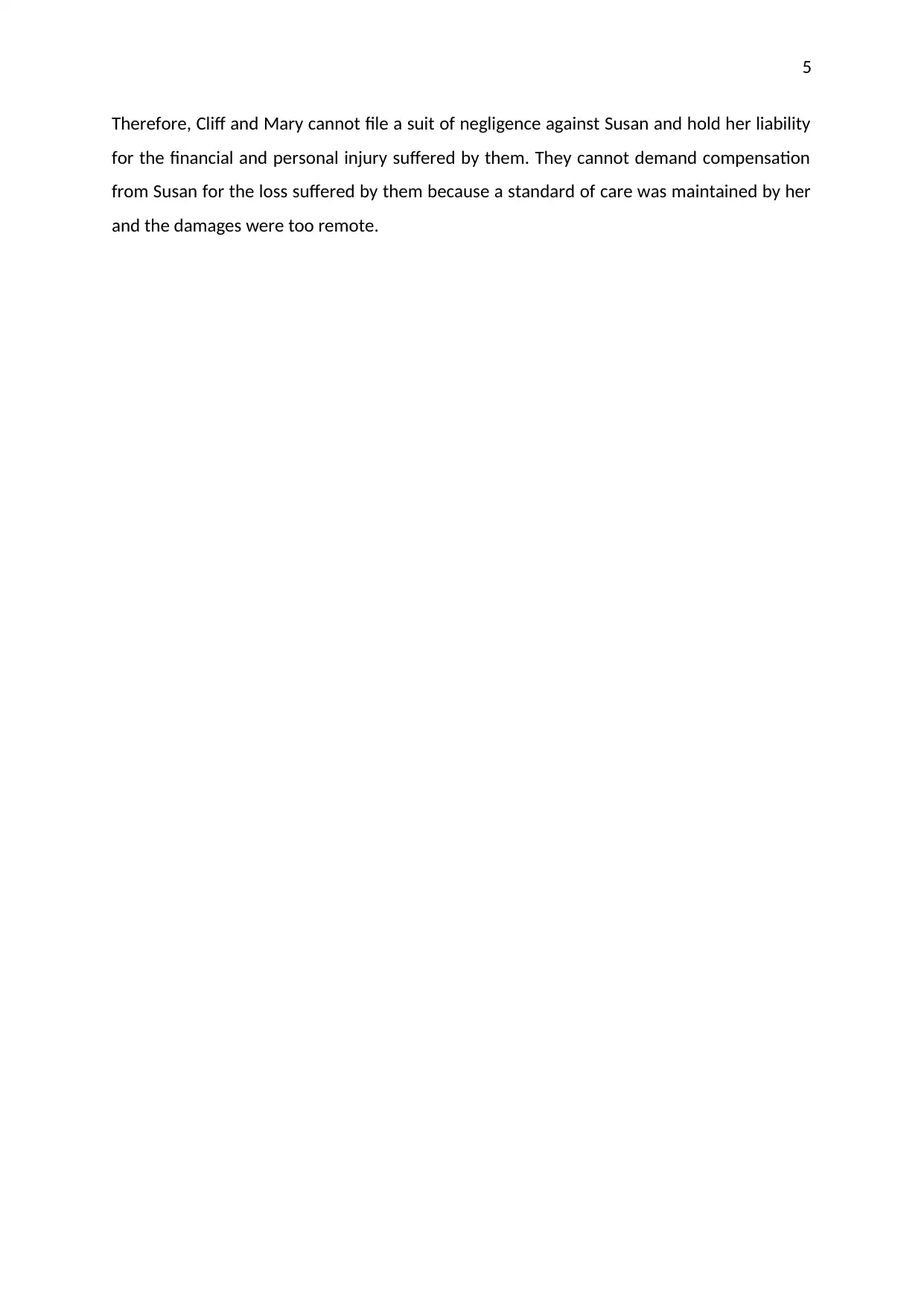
5
Therefore, Cliff and Mary cannot file a suit of negligence against Susan and hold her liability
for the financial and personal injury suffered by them. They cannot demand compensation
from Susan for the loss suffered by them because a standard of care was maintained by her
and the damages were too remote.
Therefore, Cliff and Mary cannot file a suit of negligence against Susan and hold her liability
for the financial and personal injury suffered by them. They cannot demand compensation
from Susan for the loss suffered by them because a standard of care was maintained by her
and the damages were too remote.
⊘ This is a preview!⊘
Do you want full access?
Subscribe today to unlock all pages.

Trusted by 1+ million students worldwide
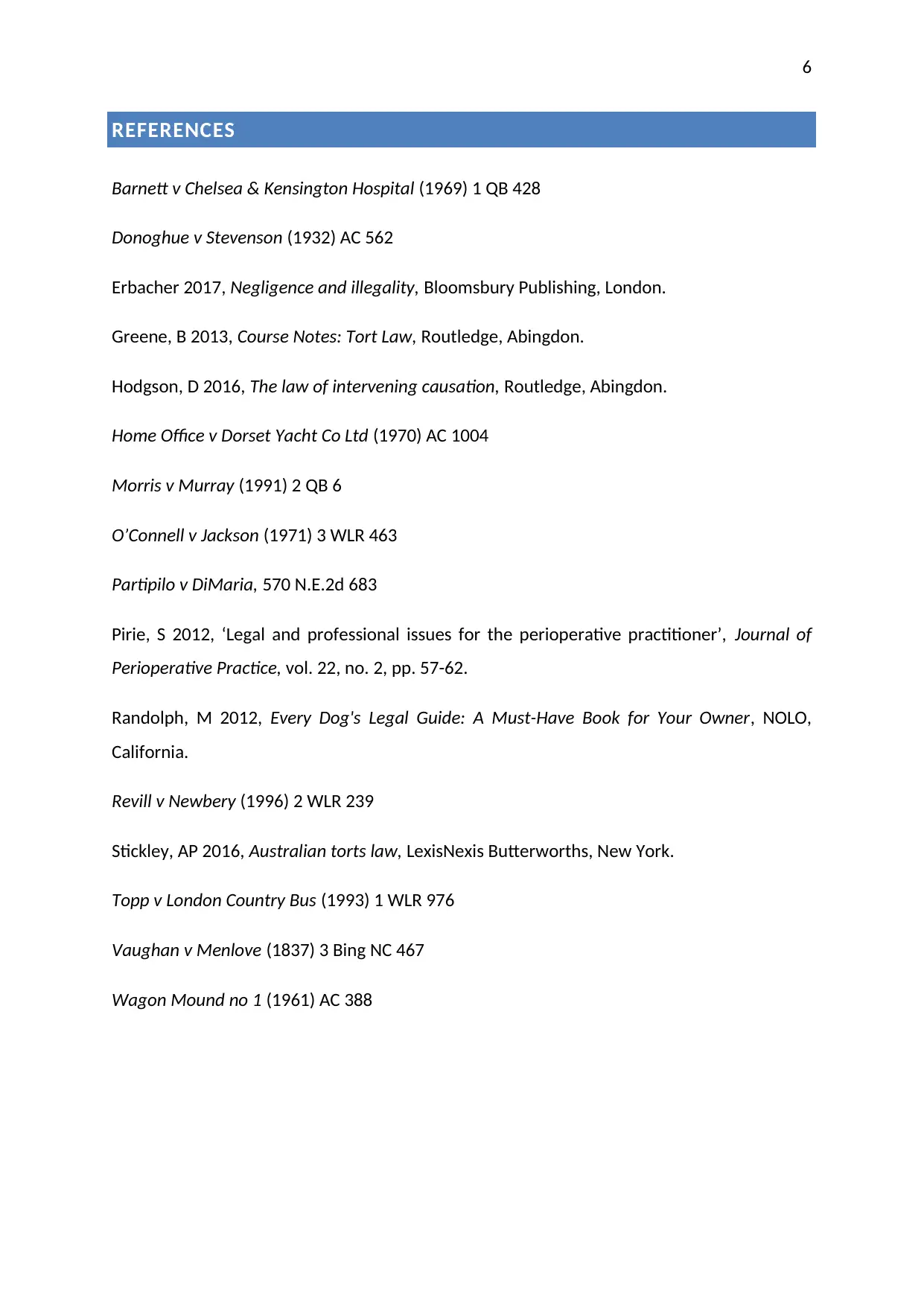
6
REFERENCES
Barnett v Chelsea & Kensington Hospital (1969) 1 QB 428
Donoghue v Stevenson (1932) AC 562
Erbacher 2017, Negligence and illegality, Bloomsbury Publishing, London.
Greene, B 2013, Course Notes: Tort Law, Routledge, Abingdon.
Hodgson, D 2016, The law of intervening causation, Routledge, Abingdon.
Home Office v Dorset Yacht Co Ltd (1970) AC 1004
Morris v Murray (1991) 2 QB 6
O’Connell v Jackson (1971) 3 WLR 463
Partipilo v DiMaria, 570 N.E.2d 683
Pirie, S 2012, ‘Legal and professional issues for the perioperative practitioner’, Journal of
Perioperative Practice, vol. 22, no. 2, pp. 57-62.
Randolph, M 2012, Every Dog's Legal Guide: A Must-Have Book for Your Owner, NOLO,
California.
Revill v Newbery (1996) 2 WLR 239
Stickley, AP 2016, Australian torts law, LexisNexis Butterworths, New York.
Topp v London Country Bus (1993) 1 WLR 976
Vaughan v Menlove (1837) 3 Bing NC 467
Wagon Mound no 1 (1961) AC 388
REFERENCES
Barnett v Chelsea & Kensington Hospital (1969) 1 QB 428
Donoghue v Stevenson (1932) AC 562
Erbacher 2017, Negligence and illegality, Bloomsbury Publishing, London.
Greene, B 2013, Course Notes: Tort Law, Routledge, Abingdon.
Hodgson, D 2016, The law of intervening causation, Routledge, Abingdon.
Home Office v Dorset Yacht Co Ltd (1970) AC 1004
Morris v Murray (1991) 2 QB 6
O’Connell v Jackson (1971) 3 WLR 463
Partipilo v DiMaria, 570 N.E.2d 683
Pirie, S 2012, ‘Legal and professional issues for the perioperative practitioner’, Journal of
Perioperative Practice, vol. 22, no. 2, pp. 57-62.
Randolph, M 2012, Every Dog's Legal Guide: A Must-Have Book for Your Owner, NOLO,
California.
Revill v Newbery (1996) 2 WLR 239
Stickley, AP 2016, Australian torts law, LexisNexis Butterworths, New York.
Topp v London Country Bus (1993) 1 WLR 976
Vaughan v Menlove (1837) 3 Bing NC 467
Wagon Mound no 1 (1961) AC 388
1 out of 7
Related Documents
Your All-in-One AI-Powered Toolkit for Academic Success.
+13062052269
info@desklib.com
Available 24*7 on WhatsApp / Email
![[object Object]](/_next/static/media/star-bottom.7253800d.svg)
Unlock your academic potential
Copyright © 2020–2025 A2Z Services. All Rights Reserved. Developed and managed by ZUCOL.





